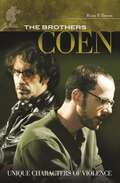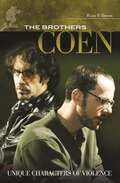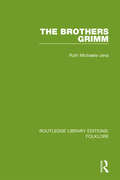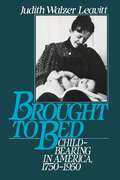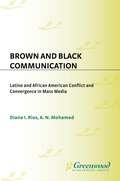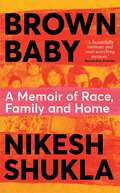- Table View
- List View
The Brotherhood of Freemason Sisters: Gender, Secrecy, and Fraternity in Italian Masonic Lodges
by Lilith MahmudFrom its traces in cryptic images on the dollar bill to Dan Brown’s The Lost Symbol, Freemasonry has long been one of the most romanticized secret societies in the world. But a simple fact escapes most depictions of this elite brotherhood: There are women Freemasons, too. In this groundbreaking ethnography, Lilith Mahmud takes readers inside Masonic lodges in contemporary Italy, where she observes the many ritualistic and fraternal bonds forged among women initiates of this elite and esoteric society. Offering a tantalizing look behind lodge doors, The Brotherhood of Freemason Sisters unveils a complex culture of discretion in which Freemasons simultaneously reveal some truths and hide others. Women—one of Freemasonry’s best-kept secrets—are often upper class and highly educated but paradoxically antifeminist, and their self-cultivation through the Masonic path is an effort to embrace the deeply gendered ideals of fraternity. Mahmud unravels this contradiction at the heart of Freemasonry: how it was at once responsible for many of the egalitarian concepts of the Enlightenment and yet has always been, and in Italy still remains, extremely exclusive. The result is not only a thrilling look at an unfamiliar—and surprisingly influential—world, but a reevaluation altogether of the modern values and ideals that we now take for granted.
The Brotherhood of Freemason Sisters: Gender, Secrecy, and Fraternity in Italian Masonic Lodges
by Lilith MahmudFrom its traces in cryptic images on the dollar bill to Dan Brown’s The Lost Symbol, Freemasonry has long been one of the most romanticized secret societies in the world. But a simple fact escapes most depictions of this elite brotherhood: There are women Freemasons, too. In this groundbreaking ethnography, Lilith Mahmud takes readers inside Masonic lodges in contemporary Italy, where she observes the many ritualistic and fraternal bonds forged among women initiates of this elite and esoteric society. Offering a tantalizing look behind lodge doors, The Brotherhood of Freemason Sisters unveils a complex culture of discretion in which Freemasons simultaneously reveal some truths and hide others. Women—one of Freemasonry’s best-kept secrets—are often upper class and highly educated but paradoxically antifeminist, and their self-cultivation through the Masonic path is an effort to embrace the deeply gendered ideals of fraternity. Mahmud unravels this contradiction at the heart of Freemasonry: how it was at once responsible for many of the egalitarian concepts of the Enlightenment and yet has always been, and in Italy still remains, extremely exclusive. The result is not only a thrilling look at an unfamiliar—and surprisingly influential—world, but a reevaluation altogether of the modern values and ideals that we now take for granted.
The Brotherhood of Freemason Sisters: Gender, Secrecy, and Fraternity in Italian Masonic Lodges
by Lilith MahmudFrom its traces in cryptic images on the dollar bill to Dan Brown’s The Lost Symbol, Freemasonry has long been one of the most romanticized secret societies in the world. But a simple fact escapes most depictions of this elite brotherhood: There are women Freemasons, too. In this groundbreaking ethnography, Lilith Mahmud takes readers inside Masonic lodges in contemporary Italy, where she observes the many ritualistic and fraternal bonds forged among women initiates of this elite and esoteric society. Offering a tantalizing look behind lodge doors, The Brotherhood of Freemason Sisters unveils a complex culture of discretion in which Freemasons simultaneously reveal some truths and hide others. Women—one of Freemasonry’s best-kept secrets—are often upper class and highly educated but paradoxically antifeminist, and their self-cultivation through the Masonic path is an effort to embrace the deeply gendered ideals of fraternity. Mahmud unravels this contradiction at the heart of Freemasonry: how it was at once responsible for many of the egalitarian concepts of the Enlightenment and yet has always been, and in Italy still remains, extremely exclusive. The result is not only a thrilling look at an unfamiliar—and surprisingly influential—world, but a reevaluation altogether of the modern values and ideals that we now take for granted.
The Brotherhood of Freemason Sisters: Gender, Secrecy, and Fraternity in Italian Masonic Lodges
by Lilith MahmudFrom its traces in cryptic images on the dollar bill to Dan Brown’s The Lost Symbol, Freemasonry has long been one of the most romanticized secret societies in the world. But a simple fact escapes most depictions of this elite brotherhood: There are women Freemasons, too. In this groundbreaking ethnography, Lilith Mahmud takes readers inside Masonic lodges in contemporary Italy, where she observes the many ritualistic and fraternal bonds forged among women initiates of this elite and esoteric society. Offering a tantalizing look behind lodge doors, The Brotherhood of Freemason Sisters unveils a complex culture of discretion in which Freemasons simultaneously reveal some truths and hide others. Women—one of Freemasonry’s best-kept secrets—are often upper class and highly educated but paradoxically antifeminist, and their self-cultivation through the Masonic path is an effort to embrace the deeply gendered ideals of fraternity. Mahmud unravels this contradiction at the heart of Freemasonry: how it was at once responsible for many of the egalitarian concepts of the Enlightenment and yet has always been, and in Italy still remains, extremely exclusive. The result is not only a thrilling look at an unfamiliar—and surprisingly influential—world, but a reevaluation altogether of the modern values and ideals that we now take for granted.
The Brotherhood of Freemason Sisters: Gender, Secrecy, and Fraternity in Italian Masonic Lodges
by Lilith MahmudFrom its traces in cryptic images on the dollar bill to Dan Brown’s The Lost Symbol, Freemasonry has long been one of the most romanticized secret societies in the world. But a simple fact escapes most depictions of this elite brotherhood: There are women Freemasons, too. In this groundbreaking ethnography, Lilith Mahmud takes readers inside Masonic lodges in contemporary Italy, where she observes the many ritualistic and fraternal bonds forged among women initiates of this elite and esoteric society. Offering a tantalizing look behind lodge doors, The Brotherhood of Freemason Sisters unveils a complex culture of discretion in which Freemasons simultaneously reveal some truths and hide others. Women—one of Freemasonry’s best-kept secrets—are often upper class and highly educated but paradoxically antifeminist, and their self-cultivation through the Masonic path is an effort to embrace the deeply gendered ideals of fraternity. Mahmud unravels this contradiction at the heart of Freemasonry: how it was at once responsible for many of the egalitarian concepts of the Enlightenment and yet has always been, and in Italy still remains, extremely exclusive. The result is not only a thrilling look at an unfamiliar—and surprisingly influential—world, but a reevaluation altogether of the modern values and ideals that we now take for granted.
Brotherhoods of Color: Black Railroad Workers and the Struggle for Equality
by Eric ARNESENFrom the time the first tracks were laid in the early nineteenth century, the railroad has occupied a crucial place in America's historical imagination. Now, for the first time, Eric Arnesen gives us an untold piece of that vital American institution--the story of African Americans on the railroad. African Americans have been a part of the railroad from its inception, but today they are largely remembered as Pullman porters and track layers. The real history is far richer, a tale of endless struggle, perseverance, and partial victory. In a sweeping narrative, Arnesen re-creates the heroic efforts by black locomotive firemen, brakemen, porters, dining car waiters, and redcaps to fight a pervasive system of racism and job discrimination fostered by their employers, white co-workers, and the unions that legally represented them even while barring them from membership. Decades before the rise of the modern civil rights movement in the mid-1950s, black railroaders forged their own brand of civil rights activism, organizing their own associations, challenging white trade unions, and pursuing legal redress through state and federal courts. In recapturing black railroaders' voices, aspirations, and challenges, Arnesen helps to recast the history of black protest and American labor in the twentieth century.Table of Contents: Prologue 1. Race in the First Century of American Railroading 2. Promise and Failure in the World War I Era 3. The Black Wedge of Civil Rights Unionism 4. Independent Black Unionism in Depression and War 5. The Rise of the Red Caps 6. The Politics of Fair Employment 7. The Politics of Fair Representation 8. Black Railroaders in the Modern Era Conclusion Notes Acknowledgments Index Reviews of this book: In this superbly written monograph, Arnesen...shows how African American railroad workers combined civil rights and labor union activism in their struggles for racial equality in the workplace...Throughout, black locomotive firemen, porters, yardmen, and other railroaders speak eloquently about the work they performed and their confrontations with racist treatment...This history of the 'aristocrats' of the African American working class is highly recommended.--Charles L. Lumpkins, Library JournalReviews of this book: Arnesen provides a fascinating look at U.S. labor and commerce in the arena of the railroads, so much a part of romantic notions about the growth of the nation. The focus of the book is the troubled history of the railroads in the exploitation of black workers from slavery until the civil rights movement, with an insightful analysis of the broader racial integration brought about by labor activism.--Vanessa Bush, BooklistReviews of this book: [An] exhaustive and illuminating work of scholarship.--Publishers WeeklyReviews of this book: Arnesen tells a story that should be of interest to a variety of readers, including those who are avid students of this country's railroads. He knows his stuff, and furthermore, reminds us of how dependent American railroads were on the backbreaking labor of racial and ethnic groups whose civil and political status were precarious at best: Irish, Chinese, Mexicans and Italians, as well as African-Americans. But Arnesen's most powerful and provocative argument is that the nature of discrimination not only led black railroad workers to pursue the path of independent unionism, it also propelled them into the larger struggle for civil rights.--Steven Hahn, Chicago Tribune
Brotherly Love: Freemasonry and Male Friendship in Enlightenment France
by Kenneth B. LoiselleFriendship, an acquired relationship primarily based on choice rather than birth, lay at the heart of Enlightenment preoccupations with sociability and the formation of the private sphere. In Brotherly Love, Kenneth Loiselle argues that Freemasonry is an ideal arena in which to explore the changing nature of male friendship in Enlightenment France. Freemasonry was the largest and most diverse voluntary organization in the decades before the French Revolution. At least fifty thousand Frenchmen joined lodges, the memberships of which ranged across the social spectrum from skilled artisans to the highest ranks of the nobility. Loiselle argues that men were attracted to Freemasonry because it enabled them to cultivate enduring friendships that were egalitarian and grounded in emotion.Drawing on scores of archives, including private letters, rituals, the minutes of lodge meetings, and the speeches of many Freemasons, Loiselle reveals the thought processes of the visionaries who founded this movement, the ways in which its members maintained friendships both within and beyond the lodge, and the seemingly paradoxical place women occupied within this friendship community. Masonic friendship endured into the tumultuous revolutionary era, although the revolutionary leadership suppressed most of the lodges by 1794. Loiselle not only examines the place of friendship in eighteenth-century society and culture but also contributes to the history of emotions and masculinity, and the essential debate over the relationship between the Enlightenment and the French Revolution.
Brothers: The Politics of Violence among the Sekani of Northern British Columbia
by Guy LanoueA provocative analysis of a nativist movement.The creation of a huge artificial lake in western Canada led to the flooding of prime hunting and trapping territory of the Sekani Indians thus depriving them of their traditional occupations and livelihood. This caused considerable social distress resulting in a drastic increase of alcohol consumption and violence and seriously disrupting social relationships. Some Sekani made efforts to create new ties of solidarity through the adoption of Pan-Indianism however this ideology did not prove effective. The author concludes that their lack of unity stemmed from the same factionalism which characterized their personal relationships.
Brothers: The Politics of Violence among the Sekani of Northern British Columbia
by Guy LanoueA provocative analysis of a nativist movement.The creation of a huge artificial lake in western Canada led to the flooding of prime hunting and trapping territory of the Sekani Indians thus depriving them of their traditional occupations and livelihood. This caused considerable social distress resulting in a drastic increase of alcohol consumption and violence and seriously disrupting social relationships. Some Sekani made efforts to create new ties of solidarity through the adoption of Pan-Indianism however this ideology did not prove effective. The author concludes that their lack of unity stemmed from the same factionalism which characterized their personal relationships.
The Brothers Coen: Unique Characters of Violence (Modern Filmmakers)
by Ryan P. DoomThis examination of the distinctive cinema of Joel and Ethan Coen explores the theme of violence in their wide-ranging body of work.The Brothers Coen: Unique Characters of Violence spans the career of the two-time Oscar-winning producer/director team, exploring the theme of violence that runs through a genre-spanning body of work, from the neo-noir of Blood Simple to the brutal comedy Burn After Reading (2008).In chapters focusing on major characters, Ryan Doom looks at the chaotic cinematic universe of the Coens, where violent acts inevitably have devastating, unintended consequences. The remarkable gallery of Coen characters are all here: hardboiled gangster Tom Regan from Miller's Crossing (1990), overmatched amateur kidnapper Jerry Lundergaard from Fargo (1996), accidental private eye "The Dude" from The Big Lebowski (1998), psychopathic assassin-for-hire Anton Chigurh from the 2007 Academy Award winner No Country for Old Men, and more.
The Brothers Coen: Unique Characters of Violence (Modern Filmmakers)
by Ryan P. DoomThis examination of the distinctive cinema of Joel and Ethan Coen explores the theme of violence in their wide-ranging body of work.The Brothers Coen: Unique Characters of Violence spans the career of the two-time Oscar-winning producer/director team, exploring the theme of violence that runs through a genre-spanning body of work, from the neo-noir of Blood Simple to the brutal comedy Burn After Reading (2008).In chapters focusing on major characters, Ryan Doom looks at the chaotic cinematic universe of the Coens, where violent acts inevitably have devastating, unintended consequences. The remarkable gallery of Coen characters are all here: hardboiled gangster Tom Regan from Miller's Crossing (1990), overmatched amateur kidnapper Jerry Lundergaard from Fargo (1996), accidental private eye "The Dude" from The Big Lebowski (1998), psychopathic assassin-for-hire Anton Chigurh from the 2007 Academy Award winner No Country for Old Men, and more.
The Brothers Grimm (RLE Folklore)
by Ruth Michaelis-JenaThis is the first modern biography of the Brothers Grimm, first published in 1970. It is a study of them in their background of late eighteenth-century and nineteenth-century Germany, and shows the position they held in their society as founders of Germanic philology, as members of the 'Göttingen Seven', and inside the circle of the German Romantics. Jacob and Wilhelm Grimm were pioneers in the recording of authentic traditional stories. Gradual revisions gave these tales the form in which they have come down to us. Even if more recently the custom has been to leave stories as they were told, the astonishing currency of the Grimms' collection is due largely to the brothers' editorial work. The Grimms' lasting fame, as Michaelis-Jena points out, may well rest on the fact that by their insistence on 'genuine and true recording' they turned the amateur antiquarian into the professional folklorist. Ruth Michaelis-Jena has worked for many years on the Brothers Grimm, and has had access to little known material at various libraries and museums in Germany.
The Brothers Grimm (RLE Folklore)
by Ruth Michaelis-JenaThis is the first modern biography of the Brothers Grimm, first published in 1970. It is a study of them in their background of late eighteenth-century and nineteenth-century Germany, and shows the position they held in their society as founders of Germanic philology, as members of the 'Göttingen Seven', and inside the circle of the German Romantics. Jacob and Wilhelm Grimm were pioneers in the recording of authentic traditional stories. Gradual revisions gave these tales the form in which they have come down to us. Even if more recently the custom has been to leave stories as they were told, the astonishing currency of the Grimms' collection is due largely to the brothers' editorial work. The Grimms' lasting fame, as Michaelis-Jena points out, may well rest on the fact that by their insistence on 'genuine and true recording' they turned the amateur antiquarian into the professional folklorist. Ruth Michaelis-Jena has worked for many years on the Brothers Grimm, and has had access to little known material at various libraries and museums in Germany.
'Brothers' or Others?: Propriety and Gender for Muslim Arab Sudanese in Egypt (Forced Migration #22)
by Anita H. FábosMuslim Arab Sudanese in Cairo have played a fundamental role in Egyptian history and society during many centuries of close relations between Egypt and Sudan. Although the government and official press describes them as "brothers" in a united Nile Valley, recent political developments in Egypt have underscored the precarious legal status of Sudanese in Cairo. Neither citizens nor foreigners, they are in an uncertain position, created in part through an unusual ethnic discourse which does not draw principally on obvious characteristics of difference. This rich ethnographic study shows instead that Sudanese ethnic identity is created from deeply held social values, especially those concerning gender and propriety, shared by Sudanese and Egyptian communities. The resulting ethnic identity is ambiguous and flexible, allowing Sudanese to voice their frustrations and make claims for their own uniqueness while acknowledging the identity that they share with the dominant Egyptian community.
Brought to Bed: Childbearing in America, 1750-1950
by Judith Walzer LeavittBased on personal accounts by birthing women and their medical attendants, Brought to Bed reveals how childbirth has changed from colonial times to the present. Judith Walzer Leavitt's study focuses on the traditional woman-centered home-birthing practices, their replacement by male doctors, and the movement from the home to the hospital. She explains that childbearing women and their physicians gradually changed birth places because they believed the increased medicalization would make giving birth safer and more comfortable. Ironically, because of infection, infant and maternal mortality did not immediately decline. She concludes that birthing women held considerable power in determining labor and delivery events as long as childbirth remained in the home. The move to the hospital in the twentieth century gave the medical profession the upper hand. Leavitt also discusses recent events in American obstetrics that illustrate how women have attempted to retrieve some of the traditional women--and family--centered aspects of childbirth.
Brought to Bed: Childbearing in America, 1750-1950
by Judith Walzer LeavittBased on personal accounts by birthing women and their medical attendants, Brought to Bed reveals how childbirth has changed from colonial times to the present. Judith Walzer Leavitt's study focuses on the traditional woman-centered home-birthing practices, their replacement by male doctors, and the movement from the home to the hospital. She explains that childbearing women and their physicians gradually changed birth places because they believed the increased medicalization would make giving birth safer and more comfortable. Ironically, because of infection, infant and maternal mortality did not immediately decline. She concludes that birthing women held considerable power in determining labor and delivery events as long as childbirth remained in the home. The move to the hospital in the twentieth century gave the medical profession the upper hand. Leavitt also discusses recent events in American obstetrics that illustrate how women have attempted to retrieve some of the traditional women--and family--centered aspects of childbirth.
Brown and Black Communication: Latino and African American Conflict and Convergence in Mass Media (Contributions to the Study of Mass Media and Communications)
by Diana Rios Ali MohamedThough Latinos and African Americans have lived together in large cities as neighbors, there is much that is still misunderstood between them. Those who live in non-diverse locales have only news and entertainment representations on which to base their information about the two cultures. This new collection of essays brings together the latest interdisciplinary works by scholars examining conflicts and convergences among Latinos and African Americans in mass-mediated and cross-cultural contexts. Contributions in the form of both empirical and critical ethnographic research present compelling works in cross-cultural relations, news, entertainment, news media, education, and community relations.^IBrown and Black Communication^R challenges those who do not think that significant projects and key research have been conducted on the two largest ethnic communities in the United States. Of certain appeal to both scholars and those with more applied needs in media, education, and public policy, this challenging collection offers a range of perspectives on two widely diverse bodies of American people.
Brown Baby: A Memoir of Race, Family and Home
by Nikesh ShuklaBrown Baby is a beautifully intimate and soul-searching memoir. It speaks to the heart and the mind and bears witness to our turbulent times' – Bernardine EvaristoHow do you find hope and even joy in a world that is racist, sexist and facing climate crisis? How do you prepare your children for it, but also fill them with all the boundlessness and eccentricity that they deserve, and that life has to offer?In Brown Baby Nikesh Shukla explores themes of racism, feminism, parenting and our shifting ideas of home. With writing that will both fill and open your heart, this by turns, heartbreaking, hilariously funny and intensely relatable memoir is dedicated to the author’s two young daughters and is in remembrance of the grandmother they never got to meet. Through love, grief, food, fatherhood and the often-cluttered experiences that make us each who we are, Shukla shows how it’s possible to believe in hope.
Brown Girl Like Me: The Essential Guidebook and Manifesto for South Asian Girls and Women
by Jaspreet KaurYou might feel that this fight is too big for you. How on earth can you dismantle so many complex, long-standing systems of oppression? My answer: piece by piece.Brown Girl Like Me is an inspiring memoir and empowering manifesto that equips women with the confidence and tools they need to navigate the difficulties that come with an intersectional identity. Jaspreet Kaur unpacks key issues such as the media, the workplace, the home, education, mental health, culture, confidence and the body, to help South Asian women understand and tackle the issues that affect them, and help them be in the driving seat of their own lives.Jaspreet pulls no punches, tackling difficult topics from mental health and menstruation stigma to education and beauty standards, from feminism to cultural appropriation and microaggressions. She also addresses complex issues, such as how to manage being a brown feminist without rejecting your own culture, and why Asian girls – the second highest performing group of students in the country – aren't seen in larger numbers in universities and head offices.Interviews with brilliant South Asian Women of all walks of life as well as academic insight show what life is really like for brown women in the diaspora. Part toolkit, part call-to-arms, Brown Girl Like Me is essential reading for South Asian women as well as people with an interest in feminism and cultural issues, and will educate, inspire and spark urgent conversations for change.
Brown in the Windy City: Mexicans and Puerto Ricans in Postwar Chicago (Historical Studies of Urban America)
by Lilia FernándezBrown in the Windy City is the first history to examine the migration and settlement of Mexicans and Puerto Ricans in postwar Chicago. Lilia Fernández reveals how the two populations arrived in Chicago in the midst of tremendous social and economic change and, in spite of declining industrial employment and massive urban renewal projects, managed to carve out a geographic and racial place in one of America’s great cities. Through their experiences in the city’s central neighborhoods over the course of these three decades, Fernández demonstrates how Mexicans and Puerto Ricans collectively articulated a distinct racial position in Chicago, one that was flexible and fluid, neither black nor white.
Brown in the Windy City: Mexicans and Puerto Ricans in Postwar Chicago (Historical Studies of Urban America)
by Lilia FernándezBrown in the Windy City is the first history to examine the migration and settlement of Mexicans and Puerto Ricans in postwar Chicago. Lilia Fernández reveals how the two populations arrived in Chicago in the midst of tremendous social and economic change and, in spite of declining industrial employment and massive urban renewal projects, managed to carve out a geographic and racial place in one of America’s great cities. Through their experiences in the city’s central neighborhoods over the course of these three decades, Fernández demonstrates how Mexicans and Puerto Ricans collectively articulated a distinct racial position in Chicago, one that was flexible and fluid, neither black nor white.
Brown in the Windy City: Mexicans and Puerto Ricans in Postwar Chicago (Historical Studies of Urban America)
by Lilia FernándezBrown in the Windy City is the first history to examine the migration and settlement of Mexicans and Puerto Ricans in postwar Chicago. Lilia Fernández reveals how the two populations arrived in Chicago in the midst of tremendous social and economic change and, in spite of declining industrial employment and massive urban renewal projects, managed to carve out a geographic and racial place in one of America’s great cities. Through their experiences in the city’s central neighborhoods over the course of these three decades, Fernández demonstrates how Mexicans and Puerto Ricans collectively articulated a distinct racial position in Chicago, one that was flexible and fluid, neither black nor white.
Brown in the Windy City: Mexicans and Puerto Ricans in Postwar Chicago (Historical Studies of Urban America)
by Lilia FernándezBrown in the Windy City is the first history to examine the migration and settlement of Mexicans and Puerto Ricans in postwar Chicago. Lilia Fernández reveals how the two populations arrived in Chicago in the midst of tremendous social and economic change and, in spite of declining industrial employment and massive urban renewal projects, managed to carve out a geographic and racial place in one of America’s great cities. Through their experiences in the city’s central neighborhoods over the course of these three decades, Fernández demonstrates how Mexicans and Puerto Ricans collectively articulated a distinct racial position in Chicago, one that was flexible and fluid, neither black nor white.
Brown in the Windy City: Mexicans and Puerto Ricans in Postwar Chicago (Historical Studies of Urban America)
by Lilia FernándezBrown in the Windy City is the first history to examine the migration and settlement of Mexicans and Puerto Ricans in postwar Chicago. Lilia Fernández reveals how the two populations arrived in Chicago in the midst of tremendous social and economic change and, in spite of declining industrial employment and massive urban renewal projects, managed to carve out a geographic and racial place in one of America’s great cities. Through their experiences in the city’s central neighborhoods over the course of these three decades, Fernández demonstrates how Mexicans and Puerto Ricans collectively articulated a distinct racial position in Chicago, one that was flexible and fluid, neither black nor white.
Brown in the Windy City: Mexicans and Puerto Ricans in Postwar Chicago (Historical Studies of Urban America)
by Lilia FernándezBrown in the Windy City is the first history to examine the migration and settlement of Mexicans and Puerto Ricans in postwar Chicago. Lilia Fernández reveals how the two populations arrived in Chicago in the midst of tremendous social and economic change and, in spite of declining industrial employment and massive urban renewal projects, managed to carve out a geographic and racial place in one of America’s great cities. Through their experiences in the city’s central neighborhoods over the course of these three decades, Fernández demonstrates how Mexicans and Puerto Ricans collectively articulated a distinct racial position in Chicago, one that was flexible and fluid, neither black nor white.




